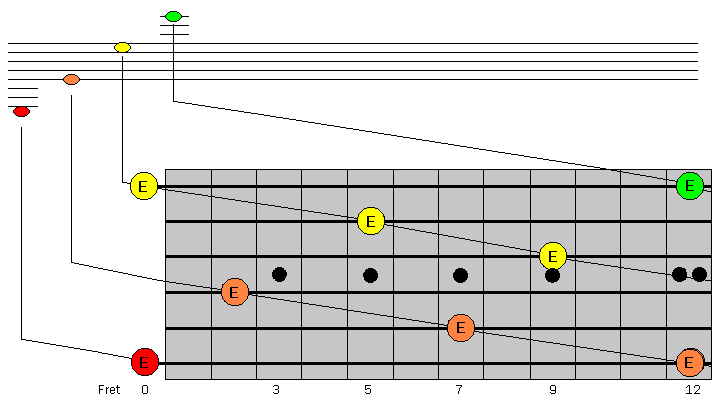
Visual Guitar TM :: Guitar, Guitar Scales, Modes, Strings, Fretboard |
::
|
C Major | C# Major | Db Major | D Major | D# Major | Eb Major | E Major | F Major | F# Major | Gb Major | G Major | G# Major | AbMajor | A Major | A# Major | Bb Major | B Major |

In this diagram all the E's in the first 12 frets are mapped and highlighted. The lowest E in pitch is red, the next higher E's are orange, followed by the yellow and green in ascending order. Note the lines of equal pitch connecting notes of the same pitch and follow the lines up to the musical staff. Each line is one octave apart. Jumping from a red E to any orange E is an interval of one octave. Going from a red E to a yellow E is 2 octaves. This arrangement of notes holds true for any note on the guitar. For example, if I highlighted all the G's, the map would look exactly the same but with every colored note 3 frets to the right.
Remember an octave refers to a doubling in pitch. Play each note along the bottom E string from the red E to the orange E. Notice there are 12 frets in one octave. Going to any orange E from the red E is equal to moving 12 frets in a straight line (horizontal). Moving left or right one fret is an interval of a half-step. Moving left or right two frets is an interval of a whole step. You can refer to them as semitones and whole tones also. The Sharp moves a note up one semitone (half-step), while a Flat moves a note down a semitone.
Intervals. On the visual guitar, when displaying interval numbers intstead of notes, a plus sign + represents going up one semitone, while a negative sign - represents going down one semitone. The interval numbers are based on the major scale. The major scale is counted 1 2 3 4 5 6 7 8. For instance, a C major scale is: 1=C, 2=D, 3=E, 4=F, 5=G, 6=A, 7=B, and 8=C. When you are reach 8, this is one octave higher than 1. So if you keep counting the next octave, you get 8 9 10 11 12 13 14 15 16 which are the same notes as before but one octave higher. This means 9 is the same as the 2, 11 is the same as the 4, and 13 is the same as the 6. You will see 9, 11 and 13 chord/arpeggios. (Chords and Arpeggios are basically the same. Chords are created from arpeggio notes but played together rather than like a scale, one at a time.) Then if you alter one of the notes, you could have 1 2 3 4 5 6 7b 8, which is a mixolydian scale. The 7th note of the major scale is made flat. On the visual guitar this may be represented by -7 which is the same as 7b (flat). So a C mixolydian scale would be 1=C, 2=D, 3=E, 4=F, 5=G, 6=A, 7b=Bb, 8=C. A major chord/arpeggio is created by 1 3 5. That is the 1st, 3rd and 5th note of the major scale. For a C Major Arpeggio, this would be 1=C, 3=E and 5=G. Select an arpeggio, then change the note display to interval on the Visual Guitar menu to view. All the chord/arpeggio numbers are based on the major scale, no matter what key you are in. Start with the major scale of the selected key, then plug in the numbers, like 1 3b 5 for a minor chord/arpeggio.
A root note is the first note of a scale or chord. In this book, the lowest root note (in pitch) will be colored Red, Orange, Yellow, Green and Blue in ascending order.
Below you can study each note's octaves, one at a time. Learning these root positions will help you greatly in all guitar studies!